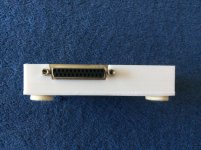bilbomacuser
Active member
I just got a SCSI2SD v5.1 and connected it to the internal SCSI cable in my Macintosh LCII. I booted from the System 6.7 startup disk, and from the System 7.01 disk tools disk, and in both cases it tells me that it cannot find any SCSI devices. I've set up the card with the suggested drive name/ID.
I'm wondering whether it's because the disks are too old, so I was going to try connecting it via the external SCSI port of a Performa 7100. I have the adaptor for the SCSI2SD, but when I looked through my old SCSI cables I discovered they were also DB25 to Centronics 50 (I think). I assume I need Mac SCSI DB25 to DB25 (male to male) - but haven't been able to find such a think. Am I correct in thinking this is the cable I need?
Without the external SCSI cable, is there anything else I should try? I don't have an easy way of getting the modified SCSI utility onto a floppy disk, but from what I've read if the appropriate device name/ID are used then it shouldn't matter.
I'm wondering whether it's because the disks are too old, so I was going to try connecting it via the external SCSI port of a Performa 7100. I have the adaptor for the SCSI2SD, but when I looked through my old SCSI cables I discovered they were also DB25 to Centronics 50 (I think). I assume I need Mac SCSI DB25 to DB25 (male to male) - but haven't been able to find such a think. Am I correct in thinking this is the cable I need?
Without the external SCSI cable, is there anything else I should try? I don't have an easy way of getting the modified SCSI utility onto a floppy disk, but from what I've read if the appropriate device name/ID are used then it shouldn't matter.




